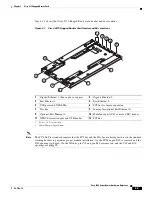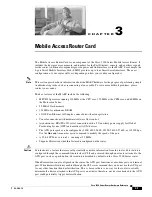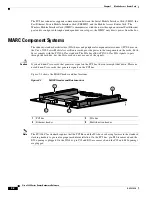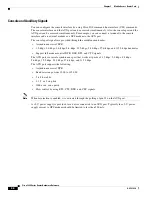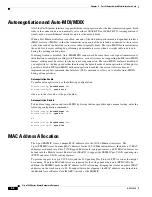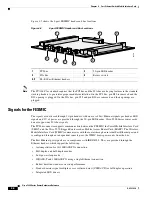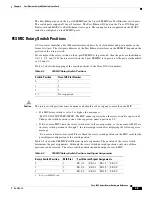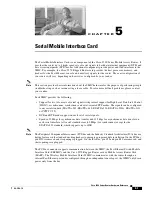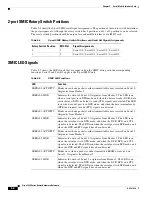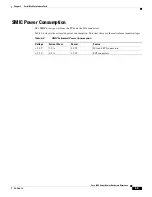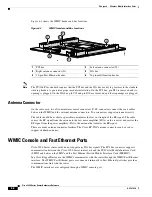
4-2
Cisco 3200 Series Router Hardware Reference
OL-5816-10
Chapter 4 Fast Ethernet Switch Mobile Interface Card
Autonegotiation and Auto-MDI/MDIX
All of the Fast Ethernet interfaces support Ethernet autonegotiation for the line transmission speed. Both
sides of the connection are automatically set to either 10BASE-TX or 100BASE-TX. Autonegotiation is
widely used on most Ethernet interfaces, and it is the default mode.
When a Fast Ethernet interface is enabled, one end of the link must perform media-dependent interface
(MDI) crossover (MDIX), so that the transmitter on one end of the data link is connected to the receiver
on the other end of the data link (a crossover cable is typically used). The Auto-MDIX feature eliminates
the need for crossover cabling by performing an internal crossover when a straight cable is detected
during the autonegotiation phase.
If autonegotiation is disabled, Auto-MDI/MDIX cannot work because there is no signal transmission at
initialization to sample the cabling with. Therefore, as in all systems not supporting the HP Auto-MDIX
feature, cabling must be correct for the devices being connected. The Auto-MDIX feature is disabled if
you explicitly set the line speed rather than leaving the default mode of autonegotiation. Although it is
possible to disable HP Auto-MDIX with autonegotiation enabled, the current software does not
implement an explicit command-line interface (CLI) command to allow you to disable Auto-MDIX
during autonegotiation.
Autonegotiation Enable
To enable autonegotiation, use the following configuration:
Router#(config)
FastEthernet
m
/
n
Router#(config-if)
speed auto
where
m
is the slot and
n
is the port number.
Autonegotiation Disable
To disable autonegotiation and Auto-MDIX by forcing the line speed through a manual setting, enter the
following configuration commands:
Router#(config)
FastEthernet
m
/
n
Router#(config-if)
speed 10
or
Router#(config)
FastEthernet
m
/
n
Router#(config-if)
speed 100
MAC Address Allocation
The 4-port FESMIC stores 4 unique MAC addresses for the 10/100 Ethernet interfaces. The
2-port FESMIC stores 2 unique MAC addresses for the 10/100 Ethernet interfaces. In addition, 37 MAC
addresses are burned into Cisco 3270 Rugged Router card–equipped routers, and 33 MAC addresses are
burned into the Mobile Access Router Card (MARC) to support the FESMIC per-VLAN spanning tree
(PVST) and inter-VLAN routing features.
To provide support for up to 32 VLANs, and the 32 Spanning Tree Protocol (STP) sessions that might
be running, 32 unique MAC addresses are required for the bridge packet data unit (BPDU) IDs. In
addition, the FESMIC needs one MAC address for VLAN routing, bringing the total of number of MAC
addresses on the wired router to 34. To support future development, the MAC addresses are burned into
the Mobile Access Router Card (MARC), instead of the FESMIC.




